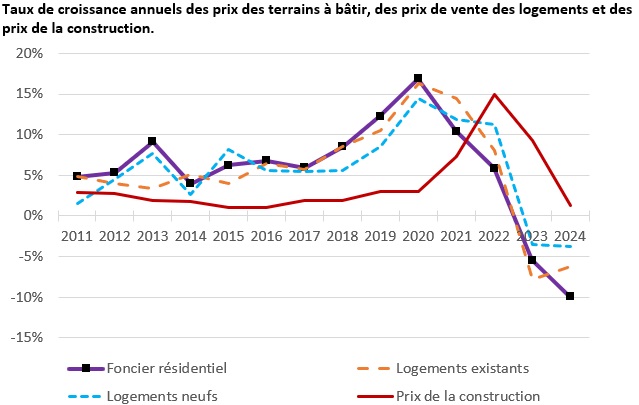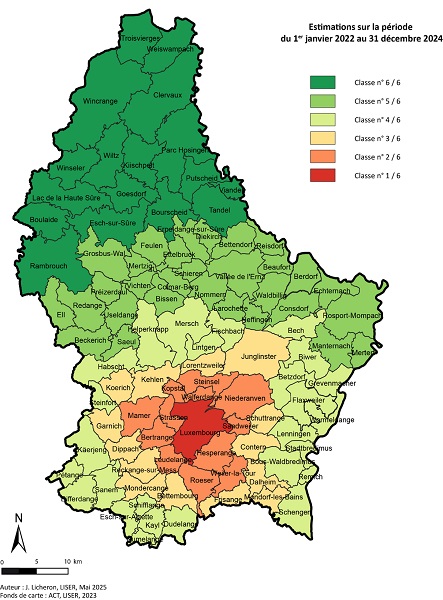 Source(s): Ministry of Housing & Spatial Planning - Housing Observatory for the residential land price index; STATEC for hedonic housing price indices; STATEC for the construction price index;
Credit: MLOGAT - Observatoire de l'Habitat
Source(s): Ministry of Housing & Spatial Planning - Housing Observatory for the residential land price index; STATEC for hedonic housing price indices; STATEC for the construction price index;
Credit: MLOGAT - Observatoire de l'Habitat
On Friday 10 October 2025, the Housing Observatory (Observatoire de l'Habitat) - under the supervision of Luxembourg's Ministry of Housing and Spatial Planning - published its Analytical Report No. 19 on the evolution of building land prices in 2023 and 2024.
As noted by the ministry, starting in mid-2022, the Luxembourg real estate market experienced a significant downturn, triggered by the sharp rise in interest rates initiated by the European Central Bank (ECB) to curb inflation. This rate increase led to a rapid decline in housing prices, with an average decline of 16.3% between the third quarter (Q3) of 2022 and the first quarter (Q1) of 2024. This decline, which brought prices back to the level of late 2020, was preceded and accompanied by a significant slowdown in market activity. Price stabilisation and a partial return to transactions were observed in the second half of 2024.
In this context, the latest analysis report published by the Housing Observatory examines the parallel or differentiated evolution of building land prices, which constitute a key factor in determining housing prices. To this end, the Housing Observatory relies on land registry data, enriched with information from the municipalities' General Development Plans (PAG). Only sales of undeveloped land intended for residential use are included, thus excluding plots built on or sold under a VEFA (off-plan sale).
A hedonic land price index is constructed based on the principle used by STATEC for housing. It allows for the isolation of actual price changes by neutralising variations in the nature of transactions. The model takes into account the specific characteristics of the plots (such as size and shape), their geographic location (particularly distance from Luxembourg City) and their immediate surroundings (proximity to amenities or nuisances).
The results show that in 2023, the building land market experienced an unprecedented contraction. The number of sales fell by more than half, from 731 in 2022 to just 326 in 2023. The ministry attributed this decline to the uncertainty generated by rising interest rates and falling property prices. In 2024, the market showed signs of recovery, with 565 sales recorded, a 73% increase compared to the previous year, although activity remained below the average observed between 2010 and 2022.
Building land prices dropped by 14.9% between 2022 and 2024, a trend very similar to that of existing apartment prices. This price decline occurred relatively evenly across the country, including in the most dynamic cantons such as Luxembourg and Esch-sur-Alzette, where the price drops reached 15.9% and 15.2% respectively.
The study also explores the geographic dimension of land prices by segmenting municipalities according to adjusted price levels, calculated using a hedonic model. This analysis results in a division into six zones, based on concentric circles around Luxembourg City, where prices are highest, as shown in the map below. According to the ministry, this division proves remarkably stable compared to the previous period (2020-2022), reflecting a well-established hierarchy of land values across the country. The municipality of Luxembourg City, at the top, has a median price of over €270,000 per are, while some municipalities in the north of the country are below €50,000.
The study thus shows that the decline in building land prices, which began in 2022, was rapid, widespread across the entire country and closely linked to the correction in the real estate market. This dynamic initially resulted in a collapse in activity in 2023, followed by a price correction that favoured a partial recovery in transactions in 2024. The territorial fundamentals of the land market, on the other hand, have changed little, with a stable price geography centred around the capital, concluded the ministry.
The full report is available (in French) here.

(Result of the municipality segmentation algorithm for a number fixed at six classes; Author: J. Licheron, LISER, May 2025; Base map: ACT, LISER, 2023; Credit: MLOGAT - Observatoire de l'Habitat)









